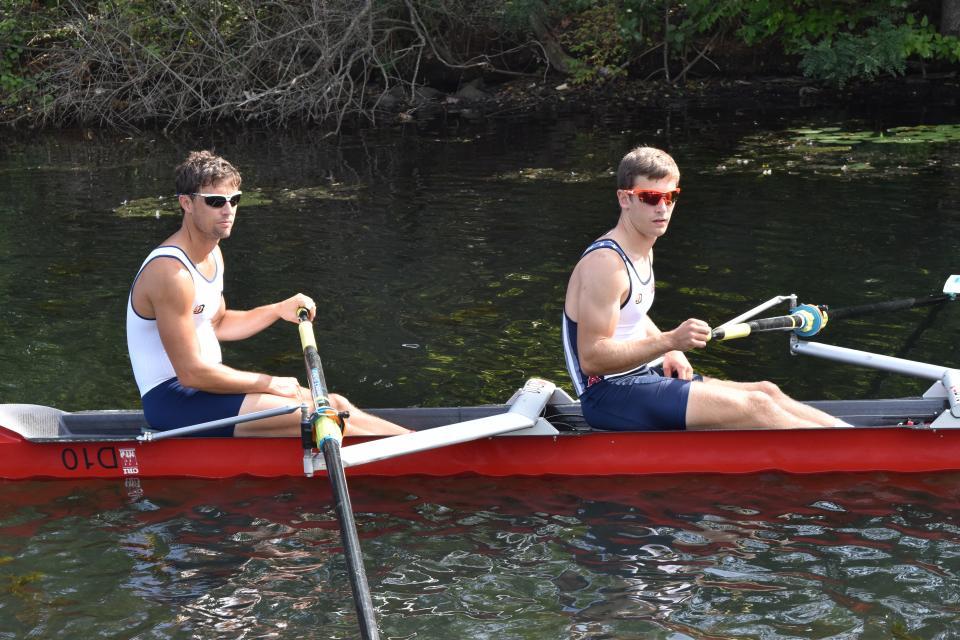From left, Paralympians Dorian Weber and Zachary Burns train on the Charles River.
Rowing coach Ellen Minzner drove a motor boat down the Charles River alongside two men in a crew boat, calling out instructions to them.
They each pulled a single oar, powerfully and in perfect unison. For this practice, two female teammates rowed in a separate boat. They look like Olympians, but each of them has a disability. This week they’re in Rio to compete in the Paralympics, which start Wednesday.
The Paralympics feature athletes with different disabilities, but a fan would have a hard time identifying what disabilities the members of this particular crew team have. The athletes say that’s entirely beside the point.
One of the rowers, Zachary Burns, was born with a club foot.
“So I only have club foot on my left leg, which was originally corrected when I was a young child through surgery," he says. "But as a result of that surgery, the left ankle has far less flexibility than a typical ankle.
He also has some muscle atrophy in his left leg — all of which limits his ability to push with that leg, something that’s key to the stroke.
It’s a similar thing for all four of the rowers. Their disabilities may not be clearly visible, but they’re real, and they’re something they have to adapt to as they compete.
Another rower, Dani Hansen, was born with damaged nerves in her left arm — a condition called Bell’s Palsy.
“I was told I wouldn’t be able to use my arm at all, for my entire life,” she says.
But she didn’t listen. Now she rows for the varsity team at the University of Washington — a national powerhouse in the sport. Hansen never thought of herself as a disabled person, because she’d always managed to compensate for the weakness in her left arm by using her right one more. But when she realized she could qualify for Paralympic rowing, she jumped at the opportunity. She does have a disability, and it can be hard when people don’t understand that.
“We have to explain to people what it is, and that’s not always the most fun thing to do," Hansen says. "Like, ‘Actually it’s difficult for me to do a pushup. I didn’t do a pushup until I was 21 years old.’ There are things that I might look like I’m able to do, but I haven’t figured out yet.”
Teammate Dorian Weber was born in the US with two club feet, but grew up mostly in “jolly old England.” He says people in the UK are excited when they hear he’s a Paralympian. “They’re like, ‘Wow, that’s amazing, that’s cool, that’s great! What did you do? What event? Did you win?' As if you would speak to a baseball star or a basketball star.”
But he gets a very different reaction in the US “Generally the first thing I’ve found in the States is, the question that gets asked is, ‘What’s wrong with you?’” he says.
Weber says Americans expect Paralympians to be missing a limb or to use a wheelchair. And of course there are a lot of athletes like that, but there’s a whole spectrum of disability. This boat is in a category for the least disabled athletes—the one who have use of their legs, trunks, and arms. There’s a point system ranking their disabilities to make sure they qualify.
“It’s not like me, with my club foot, is going to be racing someone who’s paralyzed from the waist down,” Weber says.
“People confuse the Paralympics and the Special Olympics,” says Jacklyn Smith, who's also on the team. The Special Olympics is for people with intellectual disabilities, and tends to be more about finding the courage and strength to compete. The Paralympics, Smith says, is for athletes who could probably be in the Olympics if it weren’t for disabilities they have to adapt to. The Paralympics aren’t just about competing—they're about winning.
“I don’t know if this is even politically correct to say, but in order to do well in this boat class and to medal and push the world records, you really need to find the four least disabled people that can row,” Smith says.
It’s not like they’re gaming the system. It’s how it works in their category, and she says the countries they’re competing with are doing the same thing.
Smith has ocular albinism, which means she doesn’t have any pigment in her skin or eyes, and is legally blind. She reached into her bag and pulled out a pair of sunglasses with stars and stripes on the lenses.
“It’s completely blacked out on the inside so I cannot see anything when I am rowing with these on,” Smith says.
Since she’s not fully blind, she has to wear these as a blindfold to level the playing field. She doesn’t like wearing them, but those are the rules.
Smith says because they have to adapt to compensate for their disabilities, they wind up working even harder than other elite athletes.
“I think that, you know, America as a society needs to stop looking at us as, ‘What’s wrong with you?’ and start to really appreciate what we can do,” she says.
The team will show what they can do this week in Rio. The US boat has come in silver in the last two national championships, and this time they plan to beat their rival, Great Britain, and win the gold.
